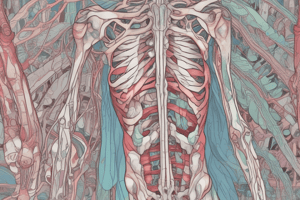Podcast
Questions and Answers
What type of cartilage is found in the external ear and epiglottis?
What type of cartilage is found in the external ear and epiglottis?
What is the main function of cardiac muscle?
What is the main function of cardiac muscle?
What is the characteristic of nervous tissue that allows it to respond to environmental changes?
What is the characteristic of nervous tissue that allows it to respond to environmental changes?
What type of muscle tissue is found in the digestive tract and blood vessels?
What type of muscle tissue is found in the digestive tract and blood vessels?
Signup and view all the answers
What is the function of fibrous cartilage?
What is the function of fibrous cartilage?
Signup and view all the answers
What is the main function of skeletal muscle tissue?
What is the main function of skeletal muscle tissue?
Signup and view all the answers
What is the primary function of adipose tissue?
What is the primary function of adipose tissue?
Signup and view all the answers
What type of cells are found in areolar tissue?
What type of cells are found in areolar tissue?
Signup and view all the answers
What is the function of ligaments?
What is the function of ligaments?
Signup and view all the answers
What type of tissue is blood?
What type of tissue is blood?
Signup and view all the answers
What is the function of fascia?
What is the function of fascia?
Signup and view all the answers
What is the primary function of epithelial tissue?
What is the primary function of epithelial tissue?
Signup and view all the answers
Which type of epithelial cell is flat and irregularly shaped and lines heart, blood and lymphatic vessels, and body cavities?
Which type of epithelial cell is flat and irregularly shaped and lines heart, blood and lymphatic vessels, and body cavities?
Signup and view all the answers
Which system is responsible for transporting oxygen and nutrients to the body's cells?
Which system is responsible for transporting oxygen and nutrients to the body's cells?
Signup and view all the answers
What is the most abundant type of tissue in the body?
What is the most abundant type of tissue in the body?
Signup and view all the answers
What is the function of exocrine glands?
What is the function of exocrine glands?
Signup and view all the answers
What is the main difference between endocrine glands and exocrine glands?
What is the main difference between endocrine glands and exocrine glands?
Signup and view all the answers
Study Notes
Connective Tissue
- Types: Fibrous (strong and tough, limits movement, prevents bone-to-bone contact), Elastic (supportive, bends easily, found in external ear and epiglottis), and Cartilage (supportive, flexible, found in joints and respiratory tract)
- Functions: Support, protection, transportation of materials, storage of energy reserves, and defense of the body
Muscle Tissue
- Types: Smooth (involuntary movement, non-striated, found in internal organs), Skeletal (voluntary movement, striated, attaches to skeleton), and Cardiac (involuntary movement, striated, found in heart)
- Functions: Movement, balance, and energy storage
Nervous Tissue
- Functions: Communication between cells, irritability, and conductivity
- Components: Neurons, nerves, and central nervous system (brain, spinal cord)
Tissue Classification
- Epithelial (protection, absorption, secretion), Connective (support, protection), Muscle (movement), and Nervous (communication)
- Types of Epithelial Tissue: Squamous (flat, irregularly shaped), Cuboidal (cubed shaped), Columnar (columnar with nucleus near bottom)
Epithelial Cells
- Squamous: lines heart, blood and lymphatic vessels, body cavities, and alveoli of lungs
- Cuboidal: lines kidney tubules and covers ovaries
- Columnar: lines ducts, digestive tract, respiratory tract, and glands
Epithelial Glands
- Endocrine Glands: produce and secrete hormones directly into bloodstream
- Exocrine Glands: produce substances excreted through ducts to outside environment
Studying That Suits You
Use AI to generate personalized quizzes and flashcards to suit your learning preferences.
Description
This quiz covers the different types of cartilage, including elastic and fibrous cartilage, and their functions in the human body. It also touches on the role of connective tissue in movement and balance.




